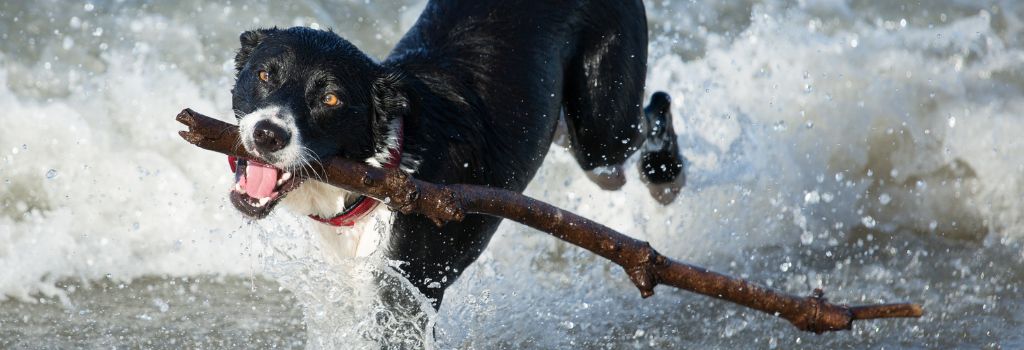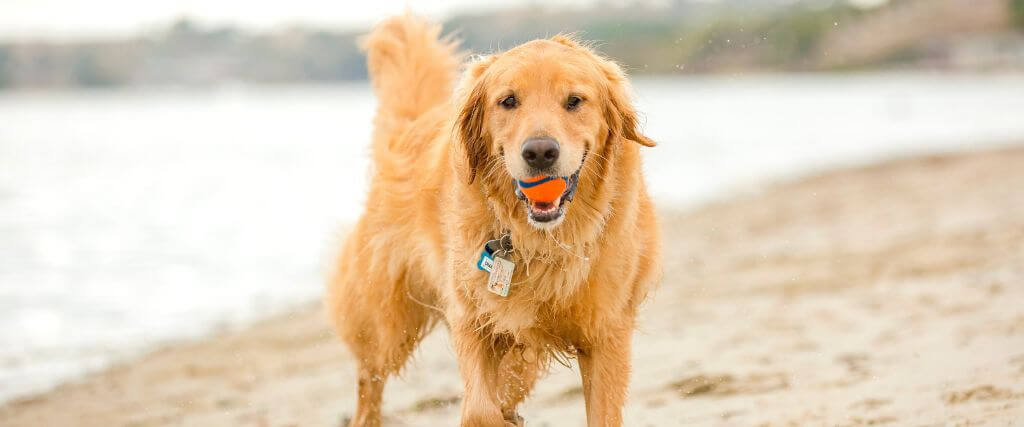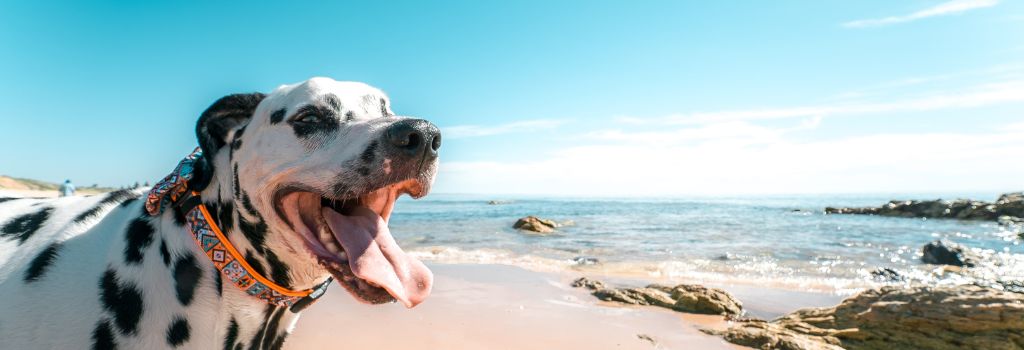Swimming and running around at the shore can be great exercise for dogs and present memorable bonding opportunities for dogs and their owners, but they don’t come without risks.
Hidden beneath the waves, buried in the sand, and lurking in seemingly harmless algae are potential dangers that can turn a fun day into a distressing ordeal. In this blog, we'll explore the hazards the beach environment can pose to your furry friend, from the hidden perils of water and sand to the sometimes toxic threat of algae. Understanding these risks can help you take the necessary precautions to ensure your dog's seaside adventures are safe and enjoyable. Let’s dive in.
What to Know About Dog Safety When It Comes to Water
Drowning
The most commonly associated risk of swimming for dogs is drowning. It is estimated that thousands of pets die from drowning each year, and these deaths are completely preventable with proper preparation and supervision.
Drowning is always a medical emergency, as it can only take minutes for organ failure and brain damage to occur. Pet owners must be aware of a few separate types of drowning and monitor their dogs for symptoms after water-related activities. They include:
- Drowning: Death from asphyxia or lack of oxygen due to water immersion
- Submersion syndrome or near drowning: These types of drowning complications related to water inhalation that require medical care
- Secondary drowning: This type of drowning is classified by death from submersion or near-drowning more than 24 hours after the incident where water has entered the lungs.
- Dry drowning: Dry drowning is similar to secondary drowning but is differentiated by the fact that water never enters the lungs in dry drowning.
Bacterial Infections and Water-Borne Illness
Bodies of water can also present several risks not associated with drowning, namely the contraction of bacterial infections. Oceans, lakes, rivers, and even pools aren’t always clean and sanitary, despite what clear waters may lead us to believe. Water is often a breeding ground for a host of bacteria species that can wreak havoc on your dog’s body.
Dogs can contract these illnesses and infections from swimming in contaminated water. Leptospirosis can cause severe kidney and liver damage, while gastrointestinal infections can be contracted from ingesting harmful bacteria like E. coli and Salmonella, leading to symptoms like vomiting and diarrhea. Stagnant or polluted water can harbor parasites such as Giardia, which can cause chronic digestive issues and dehydration in dogs.
Water Hazards and Other Conditions
Several hazards in bodies of water can create dangerous situations for dogs of all sizes and ages. Natural hazards such as currents can increase the risk of drowning or complications from swallowing large amounts of water if your dog struggles to swim or keeps its head above water. While most commonly associated with beaches, rip currents, and fast-moving tides can happen in just about any body of water. Pet owners should always check water conditions and weather forecasts before planning a day on the water.
Unnatural hazards such as debris or trash in the water present dangers to pets enjoying a swim. Broken glass, fish hooks, needles, and other sharp debris hidden in the sand or the shallows of water can injure your dog and create opportunities for infections. These dangers are heightened if your dog accidentally ingests foreign objects, leading to blockages, accidental poisoning, and other emergencies.
You should always be keeping a close eye on your dog when it is swimming, but be sure your vigilance extends to the shallows and shore, too. A watchful eye could prevent disaster on a memorable day for you and your dog.

The Dangers Lurking in the Sand
Burns & Blisters
While sand might seem small and harmless for your dog, it can create significant problems and put a damper on your day out. The first problem can happen right as you and your pet step on the sand – literally.
When planning a day out with your dog, we always recommend checking pavement temperatures to avoid burning your dog’s paw pads. Still, many pet owners don’t realize that this recommendation will also apply at the beach, lake, river bank, or anywhere else where expanses of hot sand could be present. It may seem like a beautiful sunny day, but with sandals or other footwear, you may not realize just how hot sand can get. According to research published by the National Institutes of Health, sand can reach temperatures over 100 degrees Fahrenheit when the outside temperature is only 75 degrees. As temperatures rise in the summer, the sand will only get hotter; when the ambient temperature is 90 degrees, the sand can be over 120 degrees. The hotter the sand, the faster your dog will develop blisters and burns. Burns can result in mere minutes when the temperatures are high enough, leaving your dog uncomfortable and at risk for infections and other health complications.
If you have concerns about heat and your dog’s foot health, talk to your veterinarian about potential solutions like foot coverings.
Intestinal Sand Impaction
Although rare, the following problem with sand is crucial for pet owners to be aware of — sand ingestion. Ingesting sand can cause severe complications and stomach blockages, known as intestinal sand impaction. While a few grains shouldn’t have any adverse effects for your dog, a large amount of sand mixing with water or your dog’s saliva can create an impacted mass that can cause constipation, among a slew of other side effects.
Some dogs may choose to eat because they like the taste or texture, are eating out of boredom, or may suffer from a condition called Pica, which influences strange eating habits. Aside from directly eating sand, there are a number of other ways that dogs can inadvertently ingest enough sand to cause complications, including:
- Grooming sand from their paws, face, or body
- Digging holes or running and kicking up sand
- Fetching a sandy toy
- Swallowing water with loose sand in it
Be on the lookout for these signs that your dog may be experiencing intestinal impaction if you’ve recently been around sand.
- Abdominal pain or tenderness
- Hard mass in the stomach area
- Constipation
- Restlessness
- Panting
- Vomiting
- Dehydration
- Vocalizations of pain
If your dog is exhibiting any signs of intestinal impaction, contact your veterinarian right away. Your veterinarian may utilize a physical exam or diagnostic imaging tools, such as X-rays, to determine the severity of the impaction. In some cases, IV fluid and medications are enough to help your dog pass the blockage, but in others, hospitalization and even surgery may be required.
To help avoid accidental sand ingestion, we have a few recommendations.
- Choose toys that will not hold a lot of sand or deposit sand into your dog’s mouth
- Discourage digging and any activities that may fling sand towards the face
- Thoroughly bathe and clean any sand off of your dog’s paws and body after your trip
- Watch your dog closely at all times
Don’t Forget About Algae
We have already covered the potential bacterial and water-borne illnesses that dogs can contract after a day at the beach or lake. Still, another set of risks can stem from seemingly harmless organisms in the water: algae.
Algae, particularly harmful blooms known as cyanobacteria or blue-green algae, can be highly toxic to dogs. These toxins can cause severe health issues and, in some cases, be fatal. Harmful algal blooms (HABs) are often identified by their distinct blue-green color, though they can also appear red, brown, or green. These blooms thrive in warm, nutrient-rich water and can often be found in still or slow-moving bodies of water such as lakes, ponds, and reservoirs. Pet owners must recognize these signs and avoid letting their dogs swim or drink from affected water. Environmental agencies in many states and counties will notify residents of the occurrence of dangerous algal blooms in local bodies of water, so be sure to do your research before heading out for your day of fun in the sun.
Ingesting even small amounts of contaminated water or licking algae off their fur can result in vomiting, diarrhea, drooling, weakness, and difficulty breathing. More severe cases can lead to liver damage, neurological issues, and even death, so if you suspect your dog has been exposed to toxic algae, seek veterinary care immediately.
To ensure your dog's safety around water and decrease the likelihood of any algae-related health issues, you can follow these tips:
- Avoid Stagnant Water: Stick to flowing rivers or monitored swimming areas where water quality is regularly checked.
- Look for Signs: Pay attention to any posted warnings about water quality and avoid areas with visible algae blooms.
- Rinse After Swimming: Always rinse your dog with clean water after swimming to remove any potential contaminants from their fur.
- Bring Fresh Water: Provide plenty of fresh water for your dog to drink, reducing the temptation to drink from potentially contaminated sources.
Being Proactive Can Prevent Water, Sand, and Algae Emergencies
It's crucial to remain aware of the hidden dangers that water, sand, and algae can pose to our canine companions. From the threat of drowning and bacterial infections to the hazards of sharp debris and toxic algal blooms, these risks require vigilant attention and proactive measures to ensure your dog's safety.
You can prevent accidents and health issues by understanding these potential dangers and taking the necessary precautions — such as monitoring water conditions, avoiding areas with visible algae, and keeping a close eye on your dog. With the proper preparation and awareness, you can protect your dog from the waves of danger lurking at the shore, ensuring that every trip is safe and memorable.
If you have questions and want to contact us with any questions or want to schedule an appointment, you can call us directly at 734-453-0485 or email us at [email protected]


